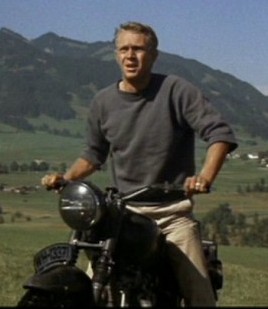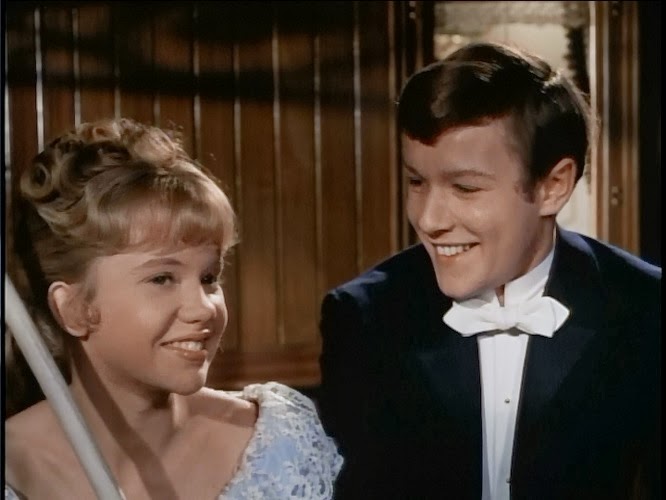The 4th of July is Independence Day in the U.S. Here are a few classic movies to watch on that day.
Nice Girl? (1941)
Deanna Durbin, a very popular star of the 1930s and 1940s, plays the overlooked daughter of a professor (
Robert Benchley) in a small town who is willing to sacrifice her reputation to get attention from someone. Anyone. Including a visiting professor, played by
Franchot Tone.
It's a
heart-warming, comedic, patriotic film, set during the initial stirrings of U.S. involvement in the European Conflict. There is a scene during the 4th of July that will have you choked up, what with Benchley nearly crying and Durbin singing "Beneath the Lights of Home."
Read the review of Nice Girl? at The Amazing Deanna Durbin BlogJava Reminisces This is one of my childhood favorites. Franchot Tone always has a bemused smirk on his face, letting you know it's all a silly comedy and everything will turn out fine.The mansion his character owns is to DIE for! I need that gigantic closet!
This is the first
Robert Stack film I recall seeing. He's a gearhead who is more in love with his car than with the girl-next-door. He suddenly needs to compete for Durbin when this sophisticated professor rolls into town. He's almost like the bashful maiden and Durbin is the Wolf.
You have to love Stack's final scene with Durbin, because he's almost emotive and human, which works perfectly for the character. You want to follow up with a sequel to see how he continually unfurls his vulnerability.
Benchley, who is known in real life for his humorous newspaper columns and short films, gives a surprisingly
nuanced and sober performance as the understanding father who protects his daughter from wagging tongues and her own foolishness. One of my favorite of his scenes is when he gives his daughter her space and tells everyone not to disturb her, after the neighbors start gossiping about a girl whom they once thought was "nice."
On the Town (1949)
This is a great standby favorite.
Turner Classic Movies will show Independence Day-themed films on the 4th of July. Their lineup includes
On the Town, a classic movie starring
Gene Kelly,
Frank Sinatra and
Jules Munshin. It's a fun little comedy about 3 sailors in the U.S. Navy on 24-hour shore leave in New York City. Read
On the Town and Musical NoirMilitary personnel on leave was a very prominent plotline of the mid-20th century. The possibilities of life-changing decisions made in an instant during a state of emergency led to rather complicated fun in comedies or trauma in the more dramatic versions of this plot.
Java Reminisces This is one of those films that I would rewind again and again as a child, learning all the choreography and dialogue. Gene Kelly indirectly taught me the Time Step.
The 3 men state from the begining that they only have 24 hours in New York. They end up back on the ship as they said they would at the beginning. But -oh!- what adventures they have in that time frame.
In terms of the plot, it reminds me of a number in Kelly's later movie,
Invitation to the Dance. In the "Ring Around the Rosy" number, we follow a bracelet as it goes from one owner to another, finally ending up with its original owner. Almost as if nothing happened at all.
Anchors Aweigh (1945)
You can compare
On the Town with another Kelly-Sinatra movie in Naval uniforms -
Anchors Aweigh. This musical comedy is also about sailors on shore leave; this time they are in Hollywood and meet a budding singing star played by
Kathryn Grayson.
Kelly was actually going into the Navy in real life immediately after wrapping up this film. Read
Anchors Aweigh and the Real Life SeamanJava Reminisces Many years ago, my sister and I ran down the steps of the Rose Bowl to reenact a scene in this film. The tour guide had no idea what we were doing, but it was fun.
It's Always Fair Weather (1955)
A film that is often contrasted with
On the Town is
It's Always Fair Weather. It also stars Gene Kelly in uniform with two other men -
Dan Dailey and
Michael Kidd. This time they are members of the U.S. Army and are happy that WWII has ended. They promise to be friends forever and meet up again. It's starts with an elated dance number in the streets, but the story sobers up as the years wear on and the friends lead separate lives. The bulk of the film is about catching up with each other and the friendship that will never be the same.
It's a deeply cynical film. Where this tone might have led musicals, we can only speculate. Musicals became less profitable soon after.
Java Reminisces As a child, I thought this film was trying too hard to capture some of the essence and originality of earlier fare. Gene Kelly performs an impressive tap dance on skates in the streets as he sings about loving a woman. This is
vaguely reminiscent of his famous Singin' in the Rain number where he literally sings in the rain while frolicking on the streets and thinking about loving a woman.
The so-in-love-I-must-dance-in-the-streets number is common in musicals, but when Gene Kelly does it, you're thinking of his most famous version of it and any other one feels like an also-ran.
The dance on skates should be appreciated for itself.
The Clock (1945)
![]() |
| Judy Garland Database |
You may also contrast
On the Town with the somber atmosphere of
The Clock, starring
Judy Garland and
Robert Young. It tells the story of a lonely soldier on leave in New York who finds a woman he wants to marry within minutes of seeing her. This is a common trope in classic films, and possible marriage to a stranger is often treated lightly, but not this time. See
The Clock (1945) - Judy Garland's Intense Boy-Meets-Girl DramaJava Reminisces I found this drama later in life, not in my childhood, and I'm glad I did. Kiddie Java would not have appreciated an MGM movie with Judy Garland not singing and dancing and smiling in it.
There are several long scenes where director/Garland's husband
Vincente Minnelli has Garland quietly react to a thought; its almost a silent film in some spots. This treatment encourages you to concentrate on Minnelli's beauteous visuals. Garland is always gorgeous... no,
ethereal... when Minnelli is behind the camera. It's like a love letter between the two.
This might be my favorite Judy Garland movie other than
The Pirate... and
A Star is Born... and...
Tomorrow is Forever (1946)
Also from the 1940s, but not from MGM, is this film about divided loyalties and love. In
Tomorrow is Forever,Claudette Colbert plays a woman who loses her husband in WWI, then is on the brink of losing her teenaged son to patriotism in WWII.
Will she allow him to serve? What are their duties as citizens? The trauma is real.
Read Tomorrow is Forever with Claudette Colbert and Orson Welles
Java Reminisces As it was with
The Clock, I found this drama later in life. I was struck by the constant, driving themes of love and loyalty. Wartime decisions are not easy to make, which I'm sure the audience of the day appreciated.
Colbert's first husband (played by
Orson Welles) says, "Let me love you in my own way," as he leaves for war and is later declared missing in action. Her second husband (
George Brent) loves her by sticking around. Her son (
Richard Long) loves his country and his mother, but is willing to disappoint her for something greater than himself.
I don't usually cry over movies, but this one had me teary-eyed.
Hit the Deck (1955)
From the same year as
It's Always Fair Weather is another film about military personnel and their troubles back home. However,
Hit the Deckis a light and frothy version of 3 sailors on shore leave. It harkens back to earlier comedic films and plays.
It stars
Russ Tamblyn,
Tony Martin and
Vic Damone as the 3 men who come home to romantic problems and family troubles. It also stars
Ann Miller,
Jane Powell,
Debbie Reynolds and all the 1950s crinoline you can handle in those big, beautiful skirts.
Java Reminisces I said during the Film Passion Blogathon that Hit the Deck is the film that turned me into a classic movie nut, but it was really a combination of films. I just happened to be watching this film as child when I thought to myself, "if I claim to love these films, then I should know when the film was made and what studio made it."
The
Hit the Deck cover art was right there, so I started learning its facts and comparing it with other MGM films. I'm basically doing the same thing today.
Further Resources What are your favorite films for Independence Day?





































































I often type the drafts using Microsoft WORD, then copy and paste the sentences onto my blog. I do this with especially long reviews or ones with footnotes. I also type with WORD when access to the internet is limited. At other times, I type directly onto my blog.
2. NOTEPAD AND PEN (occasionally)
When watching the movie at the cinema or enjoying the stage version of a film, I’ll need the pen and paper to capture my thoughts immediately. However, typing handwritten thoughts is a step I would like to avoid as much as possible since I rarely get around to typing anything once I've written it on paper. Typing thoughts onto the computer helps.3. THE MOVIE
Naturally, you'll need the movie to review. However, if I’ve seen a film dozens of times before (you know, the kind of familiar film you can quote in your sleep), I will start to write a review from memory. Following up with another glance at the film might be in order before publishing the completed review. This is just to make sure I didn't miss anything salient to my point.4. BEHIND-THE-SCENES RESOURCES
We've discussed the many credible online and offline resources which can enhance your review. Gross receipts, back stories, filming dates, what place does the film hold in the trajectory of the actor's career, filming locations, type of vehicle the character drives, interviews with filmmakers, quotes, public domain images, old newspaper articles - any of these might prove useful to your review. Discover exactly where to find this information here: 15 Classic Movie Review Resources5. INSPIRATION / BLOG IDEAS
(a) Inspiration is essential. Let's say you want to try something different on your blog. Other writers can inspire you. They might not write about classic movies or even have an online presence, but you enjoy how they formulate words or the fact that they share resources for further study. Whatever it is, figure out why that writer appeals to you and incorporate some of their writing model into your own.(b) When facing writer's block, thislist of blog ideas comes in handy. Find it here: 100 Classic Movie Blog Ideas. For the future, start your own list of blog ideas. When frustrated, you can scan some of them. Even if you do not use them, they could be the catalyst for other thoughts.
Of course, when writer's block hits, you can also free write, which is to think of a topic and just write whatever comes to mind for a couple of pages or for a limited amount of time (Here's an online 25 minute egg timer, if you need it: e.ggtimer.com/pomodoro ). You'll come out with a seed of something blog worthy.
(c) To prevent last minute posts and to always have inspiration, you can use a blogging calendar and map out every topic or movie you want to review in advance. I have used these in the past, and still do for major holidays, but I have yet to discover how best to use the blogging calendar on a weekly basis without feeling bored and confined. [See? There's a blog post right there waiting to happen.]
6. FUN
I don't know about you, but yours truly tends to take things too seriously and wipe the fun right out of it for the reader. I'm so busy trying to get everything right.
Someone recently said, "Do it and then do it right." Meaning start first, then correct as you go. But start. And remember what made you so excited in the first place about the movie you're reviewing.
What are your necessary items for a classic movie review?